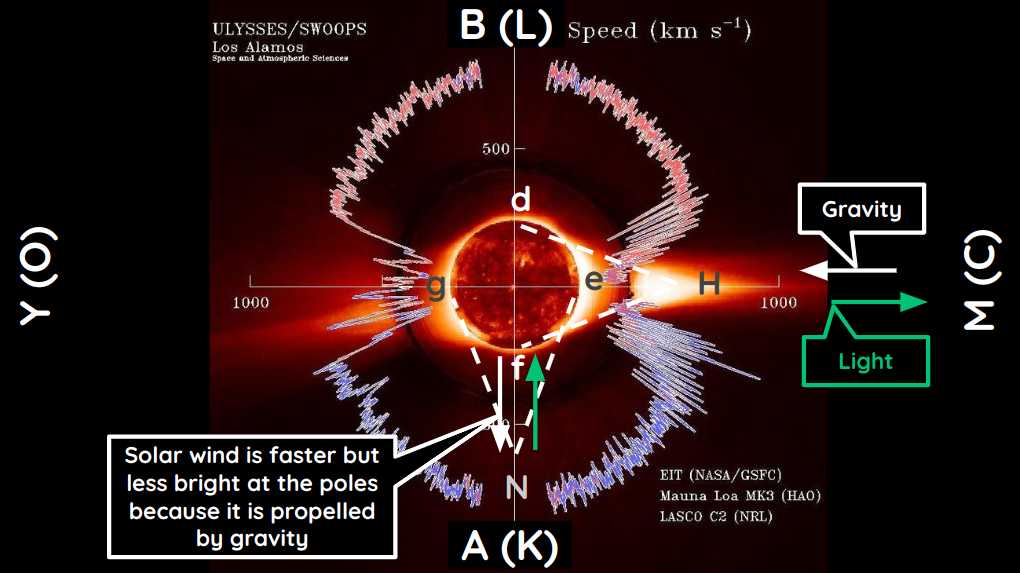The Particles of the Sun
Table of Contents
82. The air-aether near the sun is smaller and faster than those further away.
This is up to a certain distance. After that distance, all are equal in size and move faster the further they are from the sun.
Those air-aether closest to the center of each vortex are smaller and move faster than those slightly farther away. This goes on up to a certain limit.
Beyond this limit, the outer ones move faster than the inner ones.
In terms of size, they are all equal.
For example, in the first gravitational territory, the smallest air-aether particles are near the surface of the Sun at defg and slightly further away.

They gradually increase in size up to the surface of the spheroid HNQR, beyond which all are equal in size.
Those on this surface HNQR move the slowest of all, so that perhaps:
- the particles at
HQtake 30 years or more to complete one circuit around the polesAB - the particles above towards
MandY*, and below towardseandg, move faster, completing their circuits within a few weeks.
Superphysics Note
M and Y move much slower, not faster. The cause of Descartes’ error is his basing their movement on comets, which he had wrong data on. However, this might happen in other stellar systems where their star is young, growing, and more energetic. Our sun is currently getting old and so has reduced in size. This might have caused the distant parts to become slower
83. Why the most distant particles move faster than those slightly closer
The upper ones towards M and Y must move faster than the lower ones towards H and Q.
All were initially equal in size (as was fitting since we had no evidence of their inequality).
The space around their vortex is not precisely round partly because:
- surrounding vortices are not equal
- it must be narrower near the center of each of these adjacent vortices than in other parts
Sometimes some must move faster than others when they change to pass from a wider to a narrower path.
For example, 2 spheres encountering a bottleneck cannot continue unless one goes ahead of the other by moving faster.

All particles of the first gravitational territory try with all their might to move away from the center S.
As soon as one of them moves faster than its neighbors, it immediately overtakes the rest. And so the faster ones are always farther from the center.
However, the speed of their movement can only be learned through experience.
We have no experience of it except in comets*, which I will show below migrate from one sky to another.
Superphysics Note
The slowness of the circle HQ is inferred from the slowness of Saturn.
84. Why those nearest the sun move faster than those slightly further away
The circumvolution of solar matter sweeps all the adjacent part of the gravitational territory along with it.
Within the limit HQ, the particles closer to the center S complete their revolution faster than those farther away.
It is agitated very quickly and always emits some of itself through the narrow passages among the air-aether particles towards the ecliptic and receives it towards the poles.
This is why it has the power to sweep these particles along with it up to a certain distance.
We designate the limit of this distance with the ellipse HNQR, not a circle.
The Sun is spherical. But it propels the air-aether surrounding it equally:
- towards the poles
- towards the ecliptic.

However, the motion of the fire-aether, as the action called light, is stronger in the ecliptic than towards the poles.
This is why:
HandQare further fromSthanNandR- the tails of comets sometimes appear straight and sometimes curved
85. Why the fire-aether near the sun are smaller than those farther away
Within the limit HQ, the particles of air-aether nearer the center are faster and smaller than the ones farther from the center.
- If they were larger or equal, they would have more force and thus would become the upper or distant ones.
But if one is much smaller than those above it, but with the same speed, then it must always remain lower or closer to the center of the vortex than them.
Even if these particles were made exactly equal by God at the beginning, over time, some would become smaller than others due to:
- the inequality of the spaces they traverse
- the inequality of their motions.
There must be enough of these smaller particles to fill the space HNQR.
We do not compare this space to the size of the entire vortex AYBM except as a very small part.
So too must the size of the Sun be understood as very small compared to it.
Although this proportion could not be shown in the drawing here because it would have to be too vast.
There are various other inequalities in the motions of parts of the sky, especially those between S and H or Q.
86. The various motions of the air-aether particles make them perfectly spherical
The fire-aether coming from vortices like KL and similar ones are primarily carried towards the Sun.
But many parts of it are also dispersed throughout the entire vortex AYBM. From there it transitions to other vortices like C and O and similar ones.
By flowing around the air-aether particles, it causes them to move around their own centers and in other ways.
These particles are thus agitated in many different ways simultaneously.
Whatever their initial shape, they must now be perfectly spherical, not like a cylinder or any spheroid that is round in only one part.